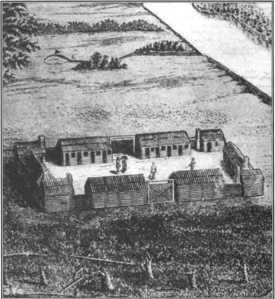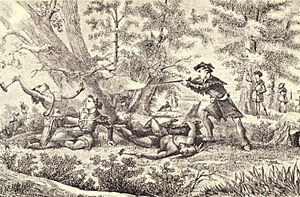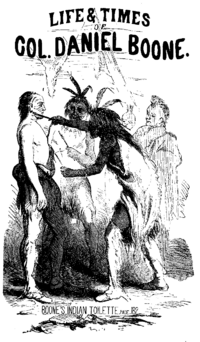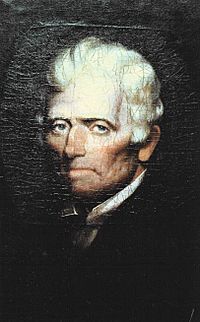Siege of Boonesborough facts for kids
Quick facts for kids Siege of Boonesborough |
|||||||
|---|---|---|---|---|---|---|---|
| Part of the American Revolutionary War | |||||||
 "Defenders in Siege of Boonesborough" by artist, Howard Pyle published in Harper's Weekly June 1887 |
|||||||
|
|||||||
| Belligerents | |||||||
Kentucky settlers |
Shawnee Detroit Militia |
||||||
| Commanders and leaders | |||||||
| Daniel Boone Richard Callaway William Bailey Smith |
Blackfish Antoine Dagneaux de Quindre Moluntha |
||||||
| Strength | |||||||
| 135 settlers, (30–40 riflemen) |
444 Native Americans 12 militia |
||||||
| Casualties and losses | |||||||
| 2 killed, 4 wounded |
37 killed, unknown wounded |
||||||

The Siege of Boonesborough was an important event during the American Revolutionary War. It happened in September 1778. The attack was on the settlement of Boonesborough in Kentucky. It was led by Chief Blackfish, a leader of the Shawnee people. The Shawnee were allied with the British during the war.
Months before the attack, Blackfish had captured Daniel Boone. Boone was the person who founded Boonesborough. Boone managed to escape from the Shawnees just in time. He then led the defense of the settlement. Chief Blackfish's attack was not successful. The siege ended after ten days. After the siege, some officers questioned Boone's loyalty. They thought he might have been too friendly with the British. But Boone was found innocent. He later moved away from Boonesborough.
Contents
Why Boonesborough Was Attacked
Settling Kentucky Lands
In 1774, the Colony of Virginia fought against Native American groups. These groups were mainly the Shawnees. This conflict was called Lord Dunmore's War. After the war, a treaty set the Ohio River as a border. It separated Shawnee lands to the north from Virginia lands to the south. But not all Native American leaders agreed with this treaty. They felt their hunting grounds were unfairly taken.
In 1775, Richard Henderson from North Carolina bought a lot of land in Kentucky. He bought it from the Cherokee people. He wanted to start a new colony called Transylvania. Daniel Boone, who worked for Henderson, created the Wilderness Trail. This path led into central Kentucky. He also built Fort Boone, which was later renamed Boonesborough. By 1776, Boonesborough became part of Virginia. Many families from the east moved there. The Shawnees were not happy about Americans moving into Kentucky. They sometimes attacked Boonesborough.
The American Revolutionary War had already started in the eastern colonies. In 1777, British officials began a new part of the war. They encouraged and armed Native American groups. These groups would raid American settlements in Kentucky. Henry Hamilton was a British leader in Canada. He was at Fort Detroit. He found allies in leaders like Chief Blackfish of the Shawnees. Blackfish hoped to push the American settlers out of Kentucky. He wanted to get their hunting grounds back. As the raids grew stronger, settlers who left their forts were often killed or captured.
Daniel Boone's Capture
Native Americans tried to make the Kentuckians leave their forts. They destroyed crops and killed cattle. They hoped food shortages would force the settlers out. The people in Boonesborough were running low on food. They needed salt to preserve the meat they had. In January 1778, Daniel Boone led thirty men to salt springs. These springs were on the Licking River.
On February 7, 1778, Boone was hunting for his group. He was surprised and captured by warriors led by Blackfish. Boone's group was greatly outnumbered. He convinced his men to surrender instead of fighting. Blackfish wanted to attack Boonesborough right away. It was not well defended then. But Boone convinced him that the women and children would not survive a winter journey as prisoners. Boone promised that Boonesborough would surrender willingly in the spring. Boone was just trying to buy time. He wanted to stop the Shawnees from attacking Boonesborough. His men did not know his plan. Many of them thought he had switched sides to the British.
Boone and his men were taken as prisoners to Blackfish's town, Chillicothe. Some prisoners were adopted into the tribe. This was a Shawnee custom to replace warriors who had died. The other prisoners were taken to Detroit. There, the British paid a reward for each prisoner. Boone was adopted into a Shawnee family in Chillicothe. He might have even joined Chief Blackfish's family. He was given the name Sheltowee, meaning "Big Turtle." Boone was watched closely, but he eventually escaped. On June 16, 1778, he learned that Blackfish was planning a big attack on Boonesborough. Boone escaped his captors. He raced home, covering 160 miles (260 km) in five days.
When Boone returned, some men doubted his loyalty. He had seemed to live happily with the Shawnees for months. Boone responded by leading a quick raid. They attacked the Shawnee village of Paint Lick Town. This raid did not achieve much. The group rushed back to Boonesborough when they found out Blackfish was marching south.
Talking Before the Fight
On September 7, 1778, Blackfish's force arrived outside Boonesborough. Boone counted 444 Native Americans and 12 white men. Most of the Native Americans were Shawnees. There were also Cherokees, Wyandots, Miamis, Delawares, and Mingos. The white men were French-Canadian soldiers from Detroit. They were fighting for the British. This was the largest force to attack Kentucky settlements. But taking a strong fort like Boonesborough without cannons would be hard.
Blackfish called Boone out of the fort to talk. He reminded Boone of his promise to surrender the settlement. Blackfish showed letters from Governor Hamilton. These letters said the settlers would be treated well if they surrendered. They would be taken to Detroit. If they did not surrender, there were no promises.
Boone told Blackfish he would share the offer with the others. He said he could not make the decision alone. Other officers had taken command during his captivity.
Inside the fort, Boone explained the situation. Everyone agreed to fight rather than surrender. They decided to make the talks last as long as possible. They expected help from Virginia to arrive soon. Boone and Major William Bailey Smith went outside again. They told Blackfish they worried the trip to Detroit would be too hard on the women and children. Blackfish pointed out he had brought 40 horses for those who could not walk. Boone asked for another day to talk with the others. Leaders from both sides smoked a ceremonial pipe together. This showed they had a peace agreement for the day. Then, they stopped talking for the day.
For the next two days, the settlers in the fort got ready for the siege. Blackfish thought there were at least 200 soldiers in the fort. This was based on wrong information from Hamilton in Detroit. In reality, there were only about 40 skilled shooters inside. The Kentuckians made it seem like they had more men. Some women in the fort dressed in men's clothes and carried weapons. On the evening of September 8, Blackfish and Boone met again. Boone told a surprised Blackfish that the fort would not surrender. Blackfish then suggested a formal meeting with all the leaders the next day.
The meeting started on September 9. Leaders from both sides shared a meal outside the fort. After eating, the council began. Both sides had gunmen ready in case of trouble. Blackfish asked "by what right had the white people taken possession of this country." Boone replied that they had bought the land from the Cherokees. A Cherokee chief confirmed this was true. Blackfish accepted this answer. He then suggested that if the settlers promised loyalty to the British king, the Shawnees would accept the Ohio River as the border. Both sides would live in peace. A treaty was then signed.
The Shawnees then came closer to shake hands. This was to seal the agreement. What happened next is not fully clear. Some believe the Shawnees tried to capture the American leaders. But many historians say there is little proof of this. A fight broke out, and gunmen from both sides started shooting. Most Americans managed to get back into the fort. Only one was left outside. He had to hide by a tree stump near the main gate. The Native Americans rushed the gate but were pushed back by heavy gunfire. The talks were over. The real siege had begun.
The last American outside spent a scary day with the battle happening around him. He finally managed to crawl inside when someone opened the gate slightly after dark.
The Siege Begins
For several days, there was a lot of gunfire. After the first burst of shooting, Boone became the main leader. He told the Kentuckians to save their gunpowder. At night, Native Americans ran up to the walls. They tried to throw burning torches onto the roofs of the houses inside. This did not work well. The warriors were easy targets for the Kentucky shooters.
On September 11, Antoine Dagneaux de Quindre, who led the Detroit soldiers, convinced the Native Americans to start digging a tunnel. They dug from the river bank towards the fort. This method is called mining. The goal was to put barrels of gunpowder in the tunnel under a part of the fort's walls. When the barrels exploded, the wall would fall down. This would create an opening for the attackers to rush in. The defenders inside the fort heard the digging. They started digging their own tunnel. They hoped to make the attackers' tunnel collapse early. The diggers on both sides even yelled insults at each other. Heavy rains caused the Native Americans' tunnel to collapse before it reached the fort.
Boone's brother, Squire Boone, was known for inventing things. He made a simple wooden cannon. It was strengthened with iron bands. It was fired once or twice at groups of Native Americans before it cracked. Squire Boone also made squirt guns from old musket barrels. These were used to put out fires on the roofs.
The Shawnees launched their final big attack on September 17. They tried again to set the fort on fire. But they were pushed back. A heavy rain also helped put out the fires. The Shawnees lost more men in this attack than on all the previous days. The next day, they slowly ended the siege. They split into smaller groups. They then raided other settlements. They caused much more damage this way than they had during the siege.
Only two people inside Boonesborough died during the siege. They were a slave named London and a settler named David Bondurant.
After the Siege
After the siege, Colonel Richard Callaway made accusations against Boone. He claimed Boone "was in favour of the British government." Captain Benjamin Logan from a nearby fort joined Callaway. Both Logan and Callaway had nephews who were captured by Boone at the salt springs. These nephews were still prisoners. In the court-martial (a military trial) held at Logan's Fort, there were four main accusations against Boone:
- Boone had surrendered the salt-making group without a fight.
- While captured, Boone had promised to surrender Boonesborough to the British.
- After returning, he led the Paint Lick expedition. This made Boonesborough weaker when Blackfish's army was expected.
- Boone put the officers in danger by agreeing to meet the Native Americans for a peace treaty outside the fort.
After hearing all the evidence, the court found Boone "not guilty." They even promoted him to major because of his brave actions. Even though he was cleared, Boone felt embarrassed by the event. He rarely talked about it again.
Boone then went to North Carolina to get his family. They had gone back there during his captivity, thinking he was dead. When Boone returned to Kentucky, he started a new settlement. It was called Boone's Station. He did not want to live in the place where he had been questioned.
While Boone was in North Carolina, a counter-attack was launched. It was against Blackfish's town of Chillicothe in the spring of 1779. Blackfish successfully defended his village. But he was shot in the leg. He later died when the wound became infected. On March 8, 1780, Richard Callaway was caught outside Boonesborough by Shawnees and was killed.
In Popular Culture
The siege of Boonesborough was shown in an episode of the 1964 CBS TV series "The Great Adventure." Peter Graves played Daniel Boone in this episode. The events are now re-enacted every year at Fort Boonesborough State Park.
The story of the Siege of Boonesborough was also the subject of a historical novel. It was written by Allan W. Eckert. The book is called The Court-Martial of Daniel Boone (1973).




